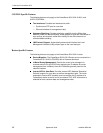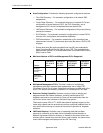
1. About the FrameSaver SLV
1-8
September 2002 9128-A2-GB20-80
DSX-1 Drop/Insert Port.
Allows DTEs/PBXs that support the DS1 signal
format to share the T1 network with other high-speed equipment so that voice
traffic can share the same local access circuit as the frame relay data.
Back-to-Back Operation.
Allows two FrameSaver devices to be connected
via a leased-line network or simulation so a point-to-point configuration can be
implemented.
Enhanced Ping Operation.
FrameSaver devices can check connectivity and
roundtrip response time to any remote device in either direction, via the
FrameSaver internal management network or the data path.
Payload Management.
Any standard, non-management DLCI can be
designated as payload managed, providing management directly from a user
data PVC, and support for Telnet, ping, SNMP, and FTP.
Optional ISDN Backup.
FrameSaver SLV 9126 and 9126-II CSU/DSUs can
be equipped with a BRI DBM, which supports up to two channels. The
channels may have different destinations. The DBM may be field-installed in
the FrameSaver SLV 9126 CSU/DSU, and must be factory-installed in the
9126-II CSU/DSU.
FrameSaver SLV 9128-II 1-slot units can be equipped with a PRI DBM, which
supports up to 23 B-channels, or a BRI DBM. Carrier-mounted FrameSaver
SLV 9128-II NAMs support a PRI DBM only.
When an ISDN BRI or PRI DBM (Basic Rate Interface or Primary Rate
Interface Dial Backup Module) is installed, the following ISDN backup features
are provided:
— Provides automatic dial backup through the ISDN for data when primary
frame relay network or access line failures occur, then automatically
restores data to the primary route when service returns to normal. Backup
is supported regardless of whether or not Caller ID is provisioned on the
ISDN circuit. A secondary backup phone number is also available to call
when a backup link cannot be established with the primary backup site.
— Supports simultaneous origination, answering, or origination and
answering backup calls, as needed, based upon how the ISDN Link
Profile is set up. This feature is also known as peer-to-peer calling.
— Provides automatic configuration of an alternate route and DLCI for
automatically created PVCs at either the remote site or central site based
upon the learned far-end DLCI number. When the automatic backup
feature is enabled, backup and restoration occur automatically.
— Provides backup timers that can be configured to better control the
amount of time required before backup is initiated, when a backup call will
be terminated once the failure condition clears, and a delay before normal
service is restored. These features are useful during periods of frequent
service disruption.
In addition, round trip latency thresholds can be configured that will initiate
backup when configured thresholds are exceeded.
— Supports backup call groups, where redundant PVCs can be assigned to
a specified call group. Using this feature, the unit only goes into backup
when
all
PVCs in the group are down, and it returns to normal service as
soon as
one
PVC in the group is operational again. This feature is useful
when multiple PVCs are going to redundant central sites.


















